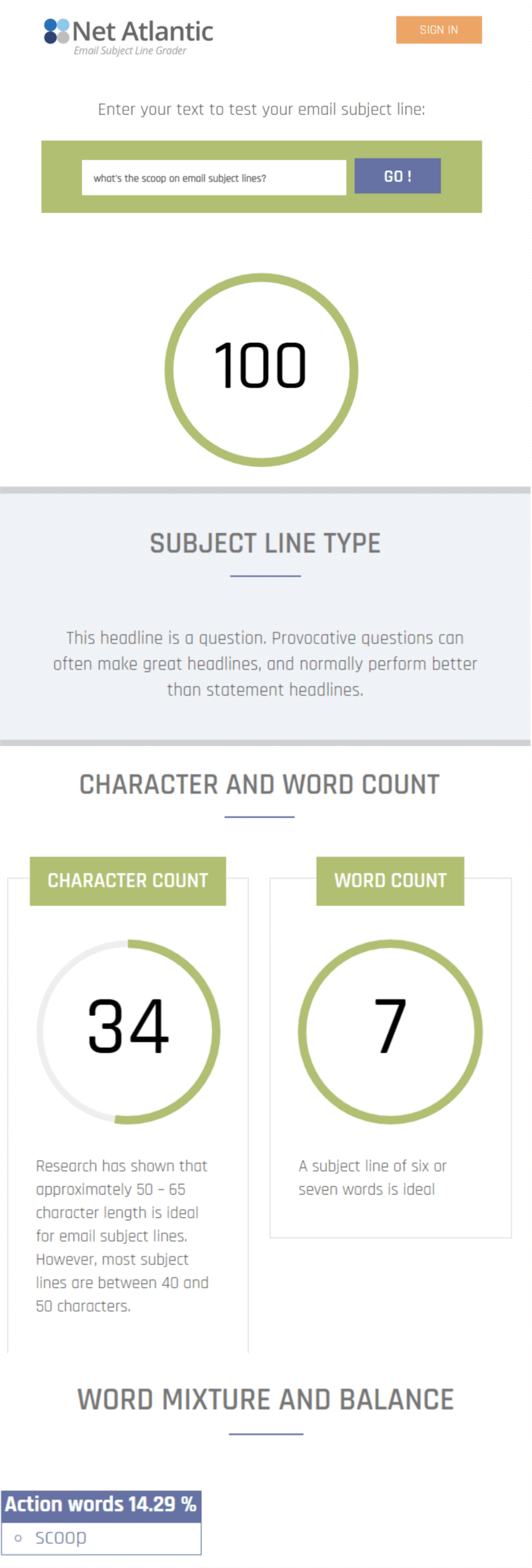
What makes the best email subject lines? I wish I could give you the definitive answer, but, alas, research on email subject lines varies. In fact, it can be downright confusing.
Let’s examine some common best practices as well as the conflicting information I discovered—beginning with the subject line for this post. I tested it with three email subject line tools, all which rank results out of 100.
CoSchedule: My subject line didn’t do very well here. It appears that I needed at least one word from the positive word bank to increase my opens.
Net Atlantic: Wow, I scored 100% even though the character count was a bit low.
SubjectLine.com: This score is reasonably good but could have been better if I had created a sense of urgency.
The infographic site, Venngage, created an infographic comparing the same subject line testers. Check the results:
Are you confused yet?
So, what will improve your results?
Open Trigger Words
Depending on which tool or supplier you use, there are specific words that can increase your email open rates. Other names for these trigger words include “power words” or “emotional words.”
What I found interesting is that certain words identified as successful on some lists are on the no-no list on others.
Check these resources for recommended open trigger words:
- “700+ Power Words That Will Boost Your Conversions” from Optinmonster.
- “The Massive 401+ List of Power Words” from Sumo.
- “Powerful words: How to use powerful language in your email marketing campaign” from sharethis.
- “Write an Irresistible Cold Email Subject Line with Power Words” from klenty.
- “100+ Words That Increase Email Subject Line Opens” from CoSchedule.
Similarly, you’ll want to avoid typical spam trigger words, too.
- “The Ultimate SPAM Trigger Words List: 474 Keywords to Avoid in 2019” from Automational.
- “100+ Common Email Spam Trigger Words and Phrases to Avoid” from SimplyCast.
- “Which keywords or characters can trigger spam filters?” from IBM.
5 Email Subject Lines Best Practices
Based on my recent online research, (and my expertise), here are some best practices for effective email subject lines:
Use emojis
- Including emoji in email subject lines leads to a 56% higher open rate compared to text-based subject lines. (SendPulse)
- Emojis have a higher ability to convey emotion. And more emotions mean your email is more memorable to recipients. They are also a great way to convey humor and stand out in the inbox. (Growth Hackers)
Cautions:
- Different email platforms display emojis differently.
- Some emojis may be ambiguous in meaning.
- Take cultural differences into account.
Personalize subject lines.
Most email service providers give you the option to add recipients’ names to your email subject lines (and in the body copy, too.) Personalized promotional emails have 29% higher unique open rates and 41% more unique click-through rates. (Experian)
Ensure your subject lines are relevant.
Know your email subscribers and send them content they want. If it’s not a good match for your products, services, or nonprofit mission, it’s OK to let them go.
Ask questions.
Asking questions in your subject line can arouse curiosity and increase open rates.
Keep subject lines short.
Email subject lines will get cut off if they’re too long, particularly on mobile devices. And with up to 77% of email opens taking place on mobile, we recommend using subject lines with fewer than 50 characters to make sure the people scanning your emails read the entire subject line. (HubSpot)
The bottom line?
Subject line studies and best practices are only good if they work for your business or nonprofit organization. As with everything in marketing, testing and tweaking will bring you closer to your best results.
















